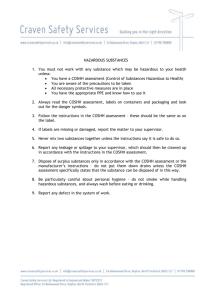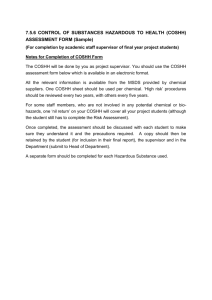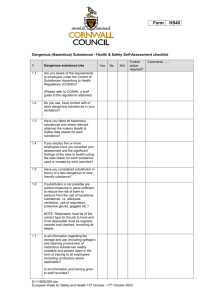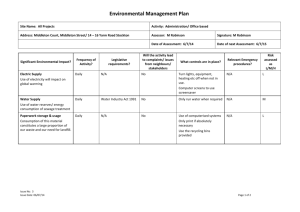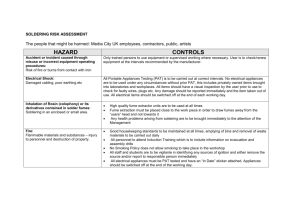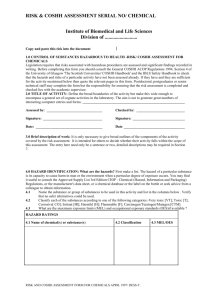control of substances hazardous to health
advertisement
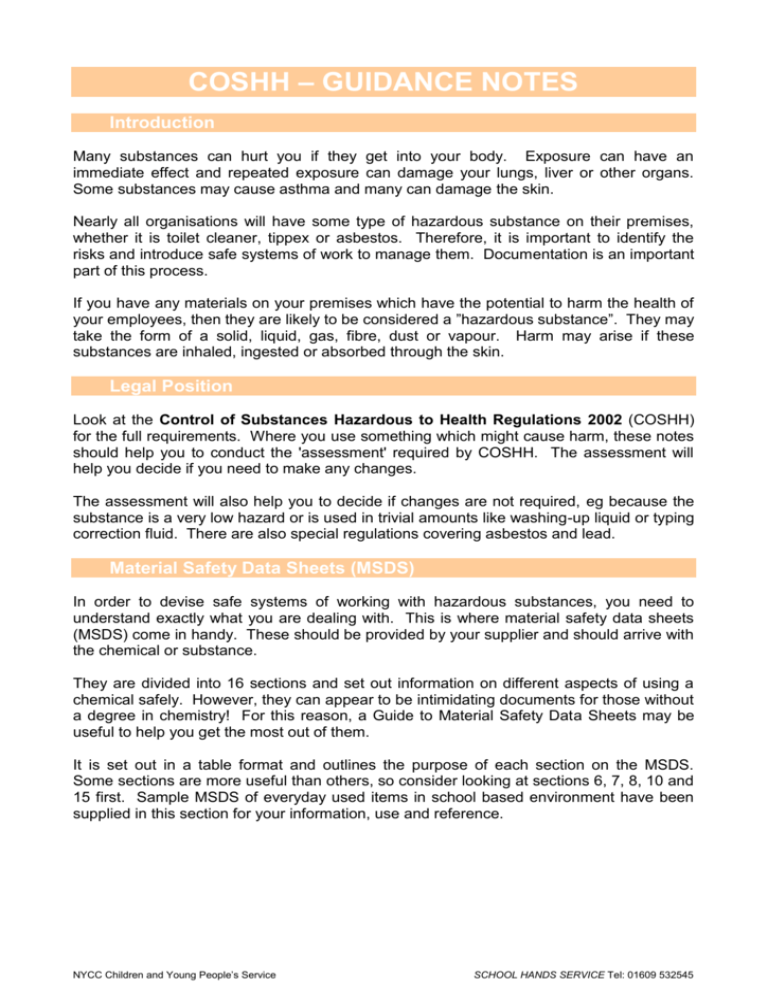
COSHH – GUIDANCE NOTES Introduction Many substances can hurt you if they get into your body. Exposure can have an immediate effect and repeated exposure can damage your lungs, liver or other organs. Some substances may cause asthma and many can damage the skin. Nearly all organisations will have some type of hazardous substance on their premises, whether it is toilet cleaner, tippex or asbestos. Therefore, it is important to identify the risks and introduce safe systems of work to manage them. Documentation is an important part of this process. If you have any materials on your premises which have the potential to harm the health of your employees, then they are likely to be considered a ”hazardous substance”. They may take the form of a solid, liquid, gas, fibre, dust or vapour. Harm may arise if these substances are inhaled, ingested or absorbed through the skin. Legal Position Look at the Control of Substances Hazardous to Health Regulations 2002 (COSHH) for the full requirements. Where you use something which might cause harm, these notes should help you to conduct the 'assessment' required by COSHH. The assessment will help you decide if you need to make any changes. The assessment will also help you to decide if changes are not required, eg because the substance is a very low hazard or is used in trivial amounts like washing-up liquid or typing correction fluid. There are also special regulations covering asbestos and lead. Material Safety Data Sheets (MSDS) In order to devise safe systems of working with hazardous substances, you need to understand exactly what you are dealing with. This is where material safety data sheets (MSDS) come in handy. These should be provided by your supplier and should arrive with the chemical or substance. They are divided into 16 sections and set out information on different aspects of using a chemical safely. However, they can appear to be intimidating documents for those without a degree in chemistry! For this reason, a Guide to Material Safety Data Sheets may be useful to help you get the most out of them. It is set out in a table format and outlines the purpose of each section on the MSDS. Some sections are more useful than others, so consider looking at sections 6, 7, 8, 10 and 15 first. Sample MSDS of everyday used items in school based environment have been supplied in this section for your information, use and reference. NYCC Children and Young People’s Service SCHOOL HANDS SERVICE Tel: 01609 532545 COSHH Assessments An essential element of a safe system of work is a COSHH Assessment. These are often confused with Material Safety Data Sheets (MSDS), but are not the same. The purpose of a COSHH assessment is to describe how the chemicals will be used in your workplace and an MSDS does not do this. You will know if this process is necessary as most commercial chemicals will contain a warning label to indicate whether COSHH applies. However, in order to save yourself unnecessary work, you could use a two part assessment process. Preliminary COSHH Assessment This allows you to identify whether or not a more in depth assessment will be necessary. For a typical low to medium risk environment such as a school, you may find that this is all that is necessary in order to keep you legally compliant. It asks you 10 questions which require brief answers. These include questions about the substance, its hazards, your control measures and whether or not they are working properly. If you complete this form and still have some doubts, you can move onto the full COSHH Assessment. (See sample supplied) COSHH Assessment The COSHH Assessment form is divided into five main sections which cover the hazards, the controls in place, their maintenance, whether elimination/substitution of the substance is possible and whether any additional controls are required. As a rule of thumb, a full assessment will be required if respiratory sensitisers such as glues are used and there are processes which generate dust and fumes. Ours contains explanatory notes to help you complete it. (See sample supplied) You may also find it helpful to use a Chemical Inventory Sheet. This will assist you in maintaining a record of all the chemicals kept on your premises. It can then be used to ensure that no chemicals are missed out when you come to carry out a COSHH assessment. Storing Chemicals If you store many chemicals on-site, you may find it helpful to use a Chemical Storeroom Checklist. It is ideal for those educational establishments which need dedicated on site chemical storage areas. Whilst a useful means of making periodic safety checks on the storage area, it is also a help in monitoring how good your safe systems of work are. Consider: The hazards of substances or their ingredients - read the labels and safety data sheets. If in doubt contact your supplier. The route into the body (breathed in, swallowed or taken in through the skin) and the worst result. The concentration or conditions likely to cause ill health. Whether you know the first symptoms of over-exposure. Who could be exposed. Don't forget contractors and members of the public. NYCC Children and Young People’s Service SCHOOL HANDS SERVICE Tel: 01609 532545 If they could be exposed accidentally, eg while cleaning, through spillage or if your controls fail. How many people are involved. How often they work with the substance. How much they work with and how long for. Substitute Do you really need to use a particular substance? Can you use a safer material or change the process? If not, here is the best order of 'control measures'. You may need more than one. Isolate or Enclose Put the harmful substances or process in a separate room or building or outside – but secure from the public. Reduce the amount used and number of people exposed, and the time they are exposed for. Use closed transfer and handling systems. Use Local Exhaust Ventilation Use a local exhaust ventilation (LEV) system which sucks dust or vapour through a small hood or booth and takes it away from the worker. A good system will: Extract dust or vapour as close as possible to its source. Control contamination of the work area below the exposure limit for the material. Suck air away form the breathing zone of the operator – not through it. Have an adequate air flow at the source of the pollutant – 1m/s at the face of a booth is a good guide. Have sufficient air flow inside the ducts to prevent dust being deposited inside and blocking them. Have duct work with gently angled bends and junctions and tapered diameter changes. Make sure air is not vented back into the work area through roof lights or windows. Special filters may be needed if the air is discharged outside or back into the room – ask your inspector for advice if in doubt. General Ventilation A good supply and circulation of fresh air will help dilute minor contamination. NYCC Children and Young People’s Service SCHOOL HANDS SERVICE Tel: 01609 532545 Good Housekeeping Simple precautions can cut exposure: Do not store chemicals in open containers such as bottles or jam jars – make sure labels are not damaged, removed or covered up. Keep dangerous chemicals locked away. Clear up spillages quickly and safely. Have smooth work surfaces to allow easy cleaning. Clean regularly using a 'dust free' method such as a vacuum system with a high efficiency filter. Keep dusty materials, waste and dirty rags in covered containers. Do not let paste or drips dry out. Good Welfare and Personal Hygiene Provide good washing and changing facilities. The Control of Lead at Work Regulations 1998 and the Control of Asbestos at Work Regulations 1987 have some particular requirements. Do not . . . Smoke, eat or drink in chemical handling areas. Siphon or pipette hazardous chemicals by mouth – use a pump/hand-operated siphon Transfer contamination, eg by putting pens and pencils in your mouth. Do . . . Remove protective clothing and wash hands before smoking, eating or drinking. Personal Protective Clothing and Equipment You must only use personal protective clothing and equipment as a last resort if you cannot control exposure in the ways outlined above. Maintaining the Controls Decide what needs to be done to ensure that the controls stay in place. This will include: Maintaining plant and equipment – all ventilation equipment must be examined and tested regularly by a competent person. Checks may include measuring the air speed or the pressures in the system, or air sampling in the work room. In general all LEV must be examined and tested every 14 months. Checking that people follow your rules. NYCC Children and Young People’s Service SCHOOL HANDS SERVICE Tel: 01609 532545 Checking that personal protective equipment is not worn out. In special cases you must monitor exposure and carry out health surveillance. Information and Training You should tell workers: The hazards. How they could be affected. What to do to keep themselves and others safe, ie how the risks are to be controlled. How to use control equipment and personal protective equipment. How to check and spot when things are wrong. The results of any exposure monitoring or health surveillance. About emergency procedures. Record and Review Except in very simple cases, you should keep a record of what you have found out and decided to do. Write down: Which exposures need to be controlled. How exposures are to be controlled. How you will maintain control. Keep an eye on things. Changes in equipment, materials or methods may require you to review your earlier decisions. In any case you should take another look at your risks at least every five years. NYCC Children and Young People’s Service SCHOOL HANDS SERVICE Tel: 01609 532545
